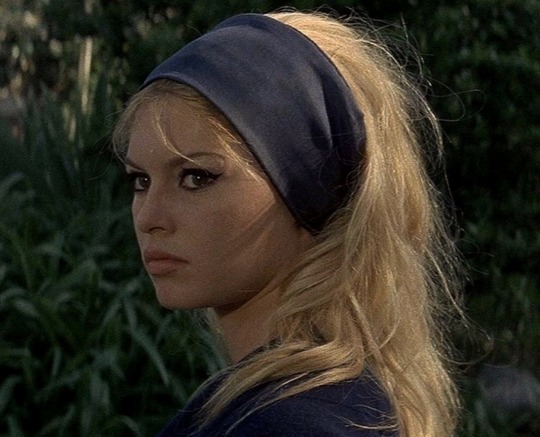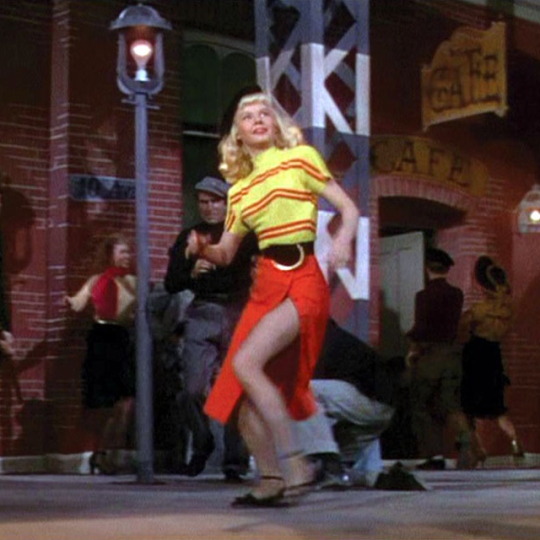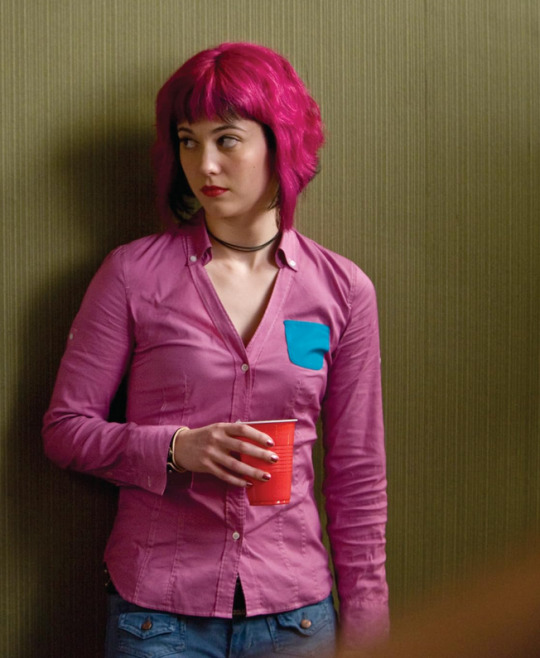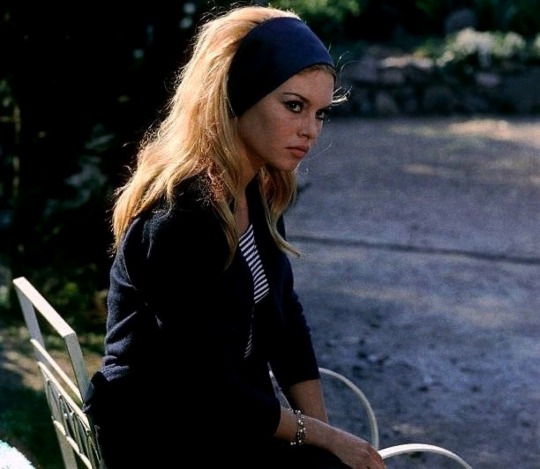#camille javal
Text

Brigitte Bardot in Le Mépris (1963)
93 notes
·
View notes
Text
Coeli's Picks: Multicolo(u)r, part 2
One Dress a Day Challenge
Birds of Prey (2020) / Margot Robbie as Harley Quinn

Contempt (Le Mépris) (1963) / Brigitte Bardot as Camille Javal

Midsommar (2019) / Florence Pugh as Dani

House of Flying Daggers (2004) / Zhang Ziyi as Xiao Mei

Mad Men (s7e4, "The Monolith") / Elisabeth Moss as Peggy Olson

The Adventures of Robin Hood (1938) / Olivia de Havilland as Maid Marian

Words and Music (1948) / Vera-Ellen as herself

Scott Pilgrim vs. the World (2010) / Mary Elizabeth Winstead as Ramona Flowers

#coeli's picks#multicolored august#multicoloured august#one dress a day challenge#one dress a week challenge#movie costumes#television costumes#tv costumes#birds of prey#contempt#Le Mépris#house of flying daggers#midsommar#mad men#words and music#scott pilgrim vs the world#mad men season 2#the adventures of robin hood
10 notes
·
View notes
Text
When it rains in the desert ~Camille Javal

3 notes
·
View notes
Link
"Contempt" tells the story of screenwriter Paul Javal, played brilliantly by Michel Piccoli, whose marriage to his wife Camille, portrayed by the enchanting Brigitte Bardot, unravels during the production of a movie. As Camille finds herself drawn to the film's producer, played by the enigmatic Jack Palance, conflicts between the worlds of art and business emerge, creating a layered narrative that delves into the essence of human relationships. Explain Contempt to America like they are 5The challenges of the French New WaveArt vs. CommerceYou want themes? Godard has themes!Lionsgate brings classic cinema to 4K UHDContempt is now available on 4K UHD Explain Contempt to America like they are 5 At its core, "Contempt" explores the tension between the pursuit of artistic integrity and the compromises required in the business of filmmaking. Godard skillfully weaves together themes of love, ambition, and the fragility of human connection, presenting a thought-provoking examination of the human condition. "Contempt" marked a significant turning point in Jean-Luc Godard's career. Known for his innovative style and rebellious approach to filmmaking, Godard ventured into the realm of big-budget productions with this film. The decision to work with renowned actors such as Bardot, Palance, and Piccoli elevated the project's profile, attracting international attention. The film's production was not without its challenges. Godard's meticulous attention to detail and his insistence on capturing the essence of filmmaking itself presented unique hurdles for the cast and crew. However, these obstacles ultimately contributed to the authenticity and realism that define "Contempt." The challenges of the French New Wave "Contempt" challenged traditional filmmaking conventions and pioneered innovative techniques. Godard's use of fragmented narratives, jump cuts, and unconventional storytelling methods broke new ground and influenced subsequent generations of filmmakers. The film's experimental approach sparked a wave of creativity and pushed boundaries within the industry, leaving an indelible mark on the art of cinema. Upon its release, "Contempt" received mixed reviews from critics. While some praised the film for its bold exploration of themes and its compelling performances, others criticized its nonlinear narrative and Godard's experimental approach. Nevertheless, "Contempt" left an indelible mark on the world of cinema, influencing subsequent generations of filmmakers who sought to push the boundaries of storytelling and redefine the cinematic experience. Art vs. Commerce "Contempt" forces us to confront the inherent tension between artistic vision and commercial demands. Through Paul Javal's struggle to maintain his artistic integrity while navigating the demands of the film industry, the film raises thought-provoking questions about the compromises artists often face. "Contempt" left an enduring legacy in the world of cinema, influencing subsequent filmmakers and shaping the course of film history. Godard's innovative storytelling techniques, such as his use of fragmented narratives and jump cuts, have been emulated by countless directors who sought to challenge traditional cinematic conventions. You want themes? Godard has themes! "Contempt" delves into the complex nature of self-identity and the destructive tendencies that can arise when individuals compromise their authenticity for the sake of external validation. Paul's gradual submission to the influence of others highlights the dangers of losing oneself in pursuit of success. The film's exploration of the relationship between art and commerce continues to resonate with audiences today. As the film industry grapples with the balance between artistic expression and financial success, "Contempt" serves as a reminder of the enduring struggle faced by filmmakers and artists alike. Lionsgate brings classic cinema to 4K UHD Contempt comes to 4K UHD after a slight delay in October and it looks better than my old Blu-ray from a decade ago. The sole special feature is an introduction by Colin MacCabe. While it's interesting, it's not something that is going to blow everyone's hair back. So, that leaves the A/V Quality to talk about right now. The A/V Quality is what most care about when it comes to decades old World Cinema. Pause for sarcasm....I'll wait. While most of the film is a visual treat, Godard kinda betrays his visual roots at points. Many dark scenes come across muddy at points without every looking really stepped on. Not sure how much of that is in the source material as it didn't seem as bad on the older Blu-ray. Still, between the DTS 2.0 HD audio track and the Dolby Vision enriched transfer, it makes up for a few moments of less than stellar visuals. Contempt is now available on 4K UHD
0 notes
Text
Assistir Filme O Desprezo Online fácil
Assistir Filme O Desprezo Online Fácil é só aqui: https://filmesonlinefacil.com/filme/o-desprezo/
O Desprezo - Filmes Online Fácil

Paul Javal é um roteirista que vai a Roma para trabalhar em uma adaptação da obra A Odisséia, que contará com a direção do cineasta alemão Fritz Lang. Enquanto decide os últimos detalhes para aceitar o trabalho, sua relação com a esposa, Camille, começa a desabar, em um jogo de paixão, ciúmes e desprezo.
0 notes
Photo




I hate you because you’re incapable of moving me
#Contempt#le mépris#jean-luc godard#camille javal#brigitte bardot#paul javal#michel piccoli#french new wave#scenephile#movie quotes#film quotes#movie scenes#film scene#movie scene
48 notes
·
View notes
Photo

I've noticed the more we doubt, the more we cling to a false lucidity, in hope of rationalizing what feelings have made murky.
#jordyn johnson#camille javal#contempt#le mépris#jean-luc godard#model#denim#Christian Diaz#photography#caitlin wronski#chanel george#naomi zinns#hairstyle#Concept Design#makeup#stylist
23 notes
·
View notes
Photo

Le Mépris (1963), dir. Jean-Luc Godard
#le mépris#jean-luc godard#brigitte bardot#michel piccoli#camille javal#paul javal#il disprezzo#alberto moravia#el desprecio#contempt#french cinema#french new wave#nouvelle vague#my own private cinema
32 notes
·
View notes
Photo

Camille Javal: http://opiniaodadesigner.com/2018/05/artista-camille-javal/
1 note
·
View note
Text

Brigitte Bardot in Le Mépris (1963)
17 notes
·
View notes
Text

(via camille javal)
#interior design ideas#paint#house painting#paint ideas#interior design#interiors#home design#home decorating ideas#home decor#apartment decor#decor#apartment design#apartment#colorful
25 notes
·
View notes
Text

Contempt / Le Mepris (1963)
Starring Brigitte Bardot,Michel Piccoli and Jack Palance
Screenwriter Paul Javal's marriage to his wife Camille disintegrates during movie production as she spends time with the producer. Layered conflicts between art and business ensue.
7 notes
·
View notes
Note
What are your favourite books about Marilyn Monroe?


The most comprehensive one, your first stop so to speak, should probably be Donald Spoto’s biography (image 1). It’s a fair and extensively researched account of her life, from the cradle to the grave. The writing is good, it’s informative, thorough, solid, believable.
Another good one is “Marilyn Monroe: Private and Confidential” by Michelle Morgan (image 2). It covers everything: it’s about 350 pages (some 200 pages less than Spoto’s hefty tome), but you’ll have reached the end before you know it.


“Fragments” contains writings by Marilyn herself. These casual scribbles, notes, poems and letters give a fascinating glimpse into her mind.
“Marilyn Monroe: My Story” started life as an autobiography in 1953, but it was scrapped, then suddenly turned up as a serial in a newspaper, disappeared again, reappeared in edited form: anyway, a long checkered history that eventually resulted in a very candid, at times intriguing account of her life, “in her own words”. Really, I’m still surprised by how frank it is. Even if parts may be colored by (later) editors, the book still is a good reflection of her original, witty, and honest personality.


Adam Victor’s “The Marilyn Encyclopedia” is exactly what you’d expect: it’s very detailed, lists everything and everyone, and it’s loaded with photos, big and small. Because it’s so detailed, it’s not without tiny mistakes: my 1999 edition lists Brigitte Bardot’s real name as Camille Javal, which was her character in the movie CONTEMPT (1963). I remember the IMDb, when it was in its infancy, having this same information so that’s where the author probably got it from. Those are minor things though, and I’m sure he corrected it in later editions. (Brigitte Bardot, by the way, was born Brigitte Anne-Marie Bardot in 1934.)
Barbara Leaming’s “Marilyn Monroe” is a very thoroughly researched account, well-written, but a little heavy on contractual stuff if that’s not your thing.


“MM--Personal: From the Private Archive of Marilyn Monroe” has photos of her possessions, telegrams, documents, snapshots, memorabilia, some jewellery. There’s always something sad about a deceased person’s belongings, the papers and items and ephemera that make up one’s life. Marilyn was notoriously sloppy, so it’s a miracle so many things have been kept still. The best bit to me is the passionate letter from an Italian fan, who fell heart over heels over head in love with her after seeing RIVER OF NO RETURN. He included a photo of himself and asked for a lock of her hair. Amused, and always game, she sent one. (She herself hated RIVER OF NO RETURN.)
Lawrence Crown’s “Marilyn at Twentieth Century Fox” was my first book on Marilyn Monroe, which is why I include it here. Remember that story about that postcard I found, which triggered my obsession? Some days later I returned to that same shop and bought this book, which chronicles the movies she made at Fox, with stories and photos. I scanned some photos from it and posted them, though you didn’t know that, because I don’t watermark or otherwise claim anything, such is my modest nature.
Wa-hey!
145 notes
·
View notes
Text
Contempt (1963) [4K UHD review]
“Contempt” tells the story of screenwriter Paul Javal, played brilliantly by Michel Piccoli, whose marriage to his wife Camille, portrayed by the enchanting Brigitte Bardot, unravels during the production of a movie. As Camille finds herself drawn to the film’s producer, played by the enigmatic Jack Palance, conflicts between the worlds of art and business emerge, creating a layered narrative…

View On WordPress
1 note
·
View note
Photo

Jeden Morgen mein Brot zu verdienen, gehe ich auf den Markt, wo Lügen verkauft werden. Hoffnungsvoll reihe ich mich ein zwischen die Verkäufer.”
(Bertolt Brecht: "Hollywood" - im Film auf französisch zitiert von Fritz Lang)
"Für das Schaffen eines Filmes genügen Träume nicht."
(Jeremy Prokosch)
"Diese Welt, in der wir leben zwingt uns immer das zu tun, was andere wollen. Warum ist das Geld so wichtig, bei allem was wir tun, was wir sind und was wir sein werden?"
(Paul Javal)
"Der Tod ist keine Lösung."
(Fritz Lang)
"Man muss stets zu Ende führen, was man angefangen hat."
(Fritz Lang)
Fritz Lang in “Die Verachtung” (“Le Mèpris”)
Deutschlands Meisterregisseur Fritz Lang war ein seiner künstlerischen Persönlichkeit adäquates filmisches Alterswerk bedauerlicherweise nicht vergönnt. In Hollywood hatte er sich ebenso mit diversen Produzenten überworfen wie mit Artur Brauner in Deutschland. Mehrere von ihm favorisierte Projekte scheiterten nicht zuletzt daran, dass sich sein Augenleiden ständig weiter verschlimmerte.
Während in Deutschland seine Filmklassiker aus den Zwanziger und Dreißiger Jahren entweder gar nicht oder lediglich in verstümmelter Form in den Kinos gezeigt wurden, priesen ihn in Frankreich die Vertreter der Nouvelle Vague. Der Regisseur Jean-Luc Godard äußerte enthusiastisch über Fritz Lang : “Er ist das Kino.”
So ist es nicht verwunderlich, dass Godard dem von ihm Verehrten 1963 eine Rolle in seinem nach einem Roman von Alberto Moravia entstandenen Film “Die Verachtung” anbot.
Die rein äußerliche Handlung ist rasch erzählt. Der amerikanische Produzent Jeremy Prokosch (Jack Palance) hat den berühmten Regisseur Fritz Lang (er selbst) engagiert, um in Italien eine Verfilmung von Homers “Die Odysee” in Szene zu setzten. Der französische Theaterautor Paul Javal (Michel Piccoli) soll das vorhandene Drehbuch nach den abwegigen Vorstellungen von Prokosch umschreiben, da dieser sich davon mehr finanziellen Gewinn verspicht. Da Javal sich in pekuniären Verlegenheiten befindet, nimmt er das Angebot an. Seine Frau Camille (Brigitte Bardot), für die Prokosch ein offenkundiges sexuelles Interesse hegt, überlässt Javal mehr oder weniger dem Produzenten, wofür diese ihre Ehemann zu verachten beginnt. Aufgrund dessen weigert sich Javal plötzlich, das geforderte Drehbuch zu verfassen, angeblich da er ausschließlich für das Theater tätig sein möchte. Nach einer erneuten Auseinandersetzung mit Camille, reist diese mit Prokosch von Capri nach Rom. Während der Autofahrt verunglücken Beide tödlich. Javal verabschiedet sich von Fritz Lang, während dieser auf Capri bleibt, um seinen Film fertig zu stellen.
Godards Werk ist ein in ruhigen Bildern mit kalten, klaren Farbtönen - es dominieren Blau und Weiß mit Rot und Gelb - gefilmter, höchst anspruchsvoller Essay über den Widerspruch zwischen Kunst und Leben, zwischen Anspruch und Wirklichkeit. “Die Verachtung” ist niveauvolles Kunstkino, das man am besten durch mehrfaches Ansehen auf sich wirken lassen sollte und das zahlreiche profunde Wahrheiten enthält.
Fritz Lang verkörpert sich selbst: voller Lebensklugheit und Noblesse, trotz des fortgeschrittenen Alters noch immer für seine künstlerischen Überzeugungen energisch kämpfend und zugleich mit einem leichten Hang zur Resignation.
Während der kultivierte Europäer Fritz Lang Hölderlin, Brecht, Dante und Corneille zitiert und über Homers “Odysee” referiert, wirft der der ebenso arrogante wie beschränkte Amerikaner, der sich allen Ernstes den griechischen Göttern verwandt fühlt aber keinerlei realen Bezug zu dem von ihm in Auftrag gegebenen Werk hat, mit Filmdosen um sich, da er deren Inhalt nicht zu begreifen vermag. Lediglich der Anblick einer nackten Statistin als Meerjungfrau während einer Mustervorführung entlockt ihm ein begeistertes Grinsen. Als Prokosch bei dem Wort Kunst sein Scheckbuch zückt, verweist ihn Fritz Lang darauf, dass es noch nicht so lange her sei, dass die Nazis bei diesem Wort den Revolver gezogen haben.
Symbolisch für die Unmöglichkeit einer vernünftigen Kommunikation zwischen den kunstbeflissenen Europäern (Lang und Javal) und dem ausschließlich von finanziellen Erwägungen getriebenem, ungehobelten Amerikaner (Prokosch), ist dass Prokoschs italienische Sekretärin Francesca Vanini (Georgia Moll) das Gesprochene ständig dolmetschen muss. Die Originalfassung ist bei diesem Film eindeutig der leider gekürzten deutschen Version vorzuziehen, kommt man doch so in den Genuss, Fritz Lang nicht nur deutsch sondern auch englisch und französisch sprechen zu hören, in einer kurzen Sequenz sogar Wiener Dialekt.
Wenn man den Meister in seinem eleganten blauen Nadelstreifenanzug, der jedoch bereits damals der aktuellen Mode nicht mehr entsprach, auf dem maroden Gelände von Cinecittà flanieren sieht und dazu Georges Delerues elegische Musik erklingt, überkommt einen unweigerlich das Gefühl, dass etwas Unwiederbringliches verloren gegangen ist.
In der letzten Szene des Films gibt Fritz Lang Regieanweisungen für seine “Odyssee”- Adaption. Es wird die Sequenz gedreht, in der der aus der Ferne heimgekehrte Odysseus erstmals seine Heimat Ithaka wiedersieht. Trotz der triumphierenden Geste des Darstellers des griechischen Helden, empfindet der Zuschauer statt dessen Wehmut und den Gedanken, dass Deutschlands bedeutendster Regisseur nach mehr als zwanzigjähriger Abwesenheit sein Vaterland nicht wieder gefunden hat.
#fritz lang#die verachtung#le mepris#sein eigentliches alterswerk#ohne ihn würde ich den film gar nicht mögen
11 notes
·
View notes
Text
youtube
JEUDI 15 SEPTEMBRE 2022 (Billet 3/3)
En guise d’hommage, suite à sa disparition, 2 ou 3 choses sur « LE MEPRIS » de Jean-Luc Godard (Source : « wikipedia.org »).
NB La bande-annonce ci-dessus n’est pas la bande-annonce originale, elle a été remontée à l’occasion d’un Festival. Mais nous aimons beaucoup cette version.
Quant à la musique du film, c’est peut-être « LA » musique de film que JM préfère à toutes les autres.
____________________________
« LE MEPRIS » est un film franco-italien réalisé par Jean-Luc Godard, sorti en 1963. Mettant en scène Brigitte Bardot, Michel Piccoli, Jack Palance et Fritz Lang, c’est une adaptation du roman « Le Mépris » (1954) d’Alberto Moravia.
SYNOPSIS
Le scénariste parisien Paul Javal et son épouse Camille rejoignent le réalisateur Fritz Lang en tournage pour le compte du producteur de cinéma américain Jeremy Prokosch, sur le plateau du film « Ulysse » (une adaptation de l’Odyssée) en chantier à la villa Malaparte à Capri en Italie.
Il est proposé à Paul Javal de reprendre et de terminer le scénario du film, ce qu'il accepte, pour des raisons économiques. Durant le séjour, Paul laisse le riche producteur seul avec Camille et encourage celle-ci à demeurer avec lui, alors qu'elle, intimidée, insiste pour rester auprès de Paul. Camille pense que son mari la laisse à la merci de Prokosch par faiblesse et pour ne pas froisser ce nouvel employeur. De là naissent des malentendus, la déchirure… le mépris, et la désagrégation du couple.
CASTING
Initialement les deux rôles principaux ont été proposés à Frank Sinatra et Kim Novak. Après le désistement de Sinatra, l’un des producteurs du « Mépris », l’Italien Carlo Ponti, propose Marcello Mastroianni pour le remplacer, avec Sophia Loren, son épouse. Godard et Georges de Beauregard, le producteur français du film, retiennent finalement Michel Piccoli et Brigitte Bardot.
TOURNAGE
Le tournage débute le 22 avril 1963 dans les studios de Cinecittà à Rome puis dans la magnifique villa Malaparte à l'est de Capri, propriété de la République Populaire de Chine, utilisée « alors comme maison de repos pour ses intellectuels ».
Il dure 32 jours, ce qui est supérieur aux habitudes godardiennes mais exceptionnellement modeste pour une production de cette envergure.
Godard, parce que Bardot refuse de mettre une jupe au-dessous du genou, la cadre plus près et la fait tourner en peignoir. Il négocie l'aplatissement de sa coiffure alors « choucroutée », s'il marche sur les mains. Il a marché sur les mains, elle a accepté d'aplatir sa choucroute.
COUAC
La première version du film présentée en juillet 1963 n'a pas du tout plu aux producteurs Carlo Ponti et Joe Levine ; en effet, la présence de Brigitte Bardot étant un atout majeur pour la production américaine, il était dès lors incompréhensible et inacceptable que le montage définitif de Godard ne comprît pas de scènes de nu de l'actrice française dont le cachet a couté la moitié du budget. Les producteurs exigent ainsi des scènes supplémentaires au début du film et au milieu, montrant Bardot et Piccoli faisant l'amour, puis vers la fin, entre Bardot et Palance.
MUSIQUE
Jean-Luc Godard commande la musique du film à Georges Delerue en 1963, dont le célèbre « thème de Camille ». Georges Delerue signe ici une de ses partitions les plus célèbres, qui sera citée ou reprise dans plusieurs autres films, notamment dans « Casino » de Martin Scorsese.
PRESSE
Jean-Louis Bory (célèbre critique cinéma de l’époque) écrit :
Le véritable « Et Dieu… créa la femme », c'est Godard qui l'a tourné et cela s'appelle « Le Mépris ». Je ne cherche pas à démêler — et peu m'importe — si Godard a respecté ou non le roman de Moravia, ou si Losey eût fabriqué un film plus moravien que Godard. « Le Mépris » que nous voyons, c'est du pur Godard et, je m'empresse de le dire, de l'excellent Godard. Le prétexte, l'objet du film, plus que le roman italien : c'est BB. Ce que Vadim a imaginé dans son premier film, mais n'a plus été capable de réaliser ensuite, ce que Louis Malle a raté dans « Vie privée », Godard l'a réussi. « Le Mépris » est le film de Bardot, parce qu'il est le film de la femme telle que Godard la conçoit et telle que Bardot l'incarne. Si le phénomène Bardot doit représenter plus tard quelque chose dans l'histoire du cinéma, au même titre que Garbo ou Dietrich, c'est dans « Le Mépris » qu'on le trouvera. Je ne sais dans quelles conditions le tournage a eu lieu ni si Bardot et Godard se sont bien entendus. Le résultat est là : il y a rarement eu entente aussi profonde (consciente ou non — consciente, je suppose, chez Godard) entre une actrice et son metteur en scène.
Et Aragon dans « Les lettres françaises » écrit :
Je vais vous le dire. J’ai vu un roman d’aujourd’hui. Au cinéma. Il s’appelle « Le Mépris », le romancier est un nommé Godard. L’écran français n’a rien eu de mieux depuis Renoir, quand Renoir était le romancier Renoir. Le voilà le génie !
_______________________________
Pour finir, une dernière anecdote. Nous avons assisté un jour, invités par une amie monteuse de film (Hélène Gagarine), à une Cérémonie des Césars. Godard, nous ne savons plus pour quelle raison, est monté sur scène et à un moment a prononcé cette phrase que nous n’avons jamais oubliée : « la différence entre la télévision et le cinéma, c’est qu’au cinéma on lève les yeux et on ferme sa gueule ! ».
0 notes